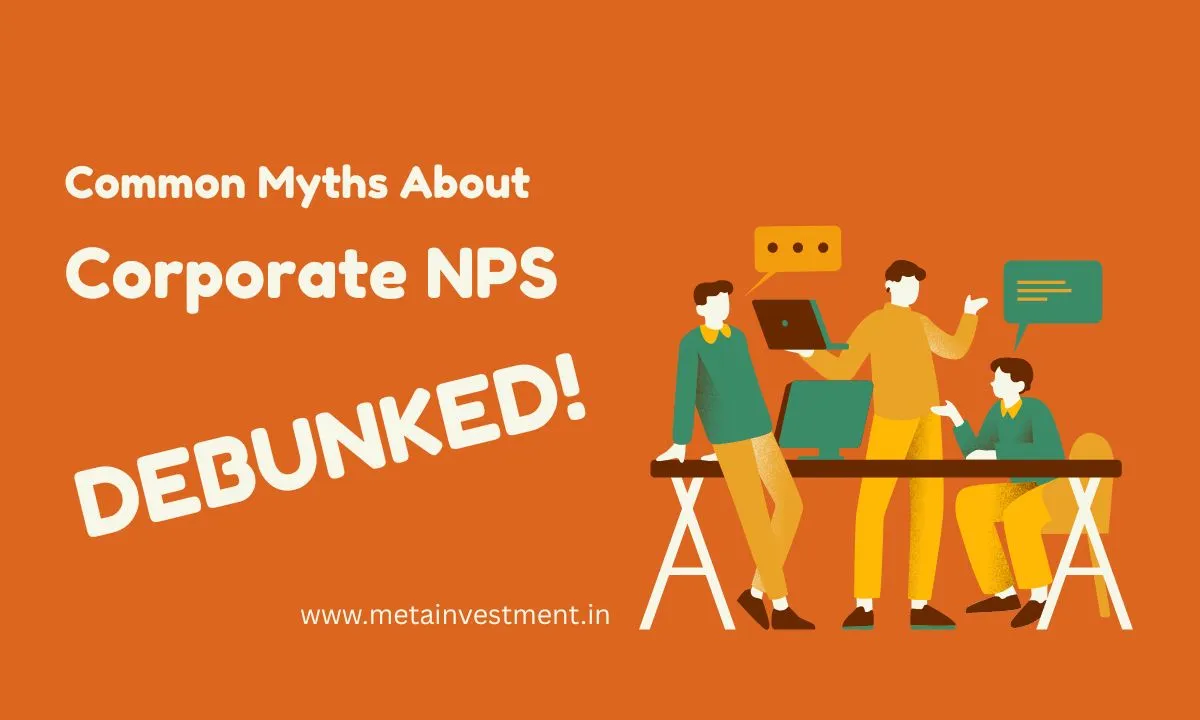The National Pension System (NPS) Corporate Model is one of India’s most tax-efficient retirement solutions. Yet, many companies hesitate to adopt it due to misinformation and myths.

Let’s bust the top myths about Corporate NPS and reveal why it’s a win-win for employers and employees.
Myth #1: “NPS Has Poor Liquidity – Employees Can’t Withdraw Funds Easily”
Reality:
✅ Partial withdrawals allowed – Employees can withdraw up to 25% of contributions after 3 years for emergencies (education, marriage, medical treatment).
✅ 60% lump sum withdrawal at retirement is tax-free, unlike EPF (taxable if withdrawn before 5 years).
Verdict: NPS offers better liquidity than perceived, with structured withdrawal options.
Myth #2: “NPS Returns Are Unpredictable & Risky”
Reality:
✅ Market-linked but diversified – NPS invests in equity (E), corporate bonds (C), and government securities (G). Employees can choose their risk profile (Auto/Auto).
✅ Consistent returns – Historically, NPS has delivered 8-10% returns, outperforming FDs and PPF.
Verdict: NPS provides better long-term growth than fixed-income schemes.
Myth #3: “Employer Contributions to NPS Are Taxable for Employees”
Reality:
✅ Tax-free employer contributions – Up to 10% of salary (Basic + DA) is deductible under Section 80CCD(2) for employees.
✅ Additional ₹50,000 deduction under Section 80CCD(1B) beyond the ₹1.5L limit of 80C.
Verdict: NPS offers extra tax savings unmatched by EPF or other schemes.
Myth #4: “NPS is Complicated to Implement for Employers”
Reality:
✅ Simple registration – Employers can register via a Point of Presence (POP) like banks.
✅ Easy payroll integration – Contributions can be automated alongside salary processing.
✅ Minimal paperwork – No complex compliance (unlike EPF).
Verdict: NPS is easier to manage than traditional PF schemes.
Myth #5: “Annuity Purchases Make NPS a Bad Deal”
Reality:
✅ Only 40% annuity mandate – Employees keep 60% lump sum tax-free.
✅ Flexible annuity options – Multiple pension providers offer higher annuity rates than traditional plans.
Verdict: The annuity ensures lifetime pension security, making NPS a complete retirement solution.
Myth #6: “Switching Jobs Means Losing Your NPS Corpus”
Reality:
✅ PRAN is portable for life – Your Permanent Retirement Account Number (PRAN) stays the same across employers.
✅ No corpus loss – The accumulated NPS funds remain intact in your account, regardless of job changes.
✅ Easy employer switching – New employers can continue contributions to your existing PRAN; no need to open a new account.
Verdict: NPS is job-change-proof—your corpus grows seamlessly throughout your career.
Conclusion: Don’t Let Myths Hold You Back!
Corporate NPS is a powerful, tax-efficient, and employee-friendly retirement scheme that beats EPF in returns, flexibility, and tax benefits.
📌 Key Takeaways:
✔ Job switches don’t affect your NPS corpus (PRAN is permanent).
✔ Better liquidity than EPF.
✔ Higher long-term returns.
✔ Maximum tax savings for employers & employees.
✔ Simple to implement and manage.
🚀 Ready to adopt Corporate NPS?
📞 Call +91-9309806281 or mail us at info@metainvestment.in for a free consultation!
—
Why This Matters for Employers?
- Employees value portability—they won’t resist job changes fearing retirement fund loss.
- Highlight this in employee education sessions to boost NPS adoption.
No. Your PRAN (Permanent Retirement Account Number) stays with you for life. You can transfer your NPS account to new employers or continue self-contributions.
Partial withdrawals (up to 25%) are allowed after 3 years for specific needs. Full withdrawal is only permitted at retirement (60% tax-free) or under exceptional circumstances.
Not necessarily. While NPS has equity exposure (up to 75%), the Auto Choice option automatically reduces risk as you age. Historically, NPS has delivered 8-10% returns.
No. Employer contributions up to 10% of salary (Basic + DA) are tax-free under Section 80CCD(2). This is over-and-above the ₹1.5L limit under 80C.
Your corpus remains intact. You can: Continue as a voluntary subscriber , Transfer to new employer's NPS , Let it grow until retirement
Yes, but it ensures lifetime pension. The remaining 60% is completely tax-free lump sum - unlike EPF which taxes early withdrawals.
Yes. NRIs can maintain NPS accounts and even contribute, though some tax implications may apply based on DTAA agreements.
NPS withdrawals are processed within 10-15 days (vs EPF's 20-25 days). The entire process is online through CRA (Central Recordkeeping Agency).
Yes. You can nominate up to 3 beneficiaries, and unlike EPF, nominees can receive 100% corpus tax-free in case of subscriber's demise.
Lower administrative burden. Better returns (market-linked). Extra tax savings (10% deduction under Sec 36(1)(iv)(a)). No mandatory contributions for employees.













